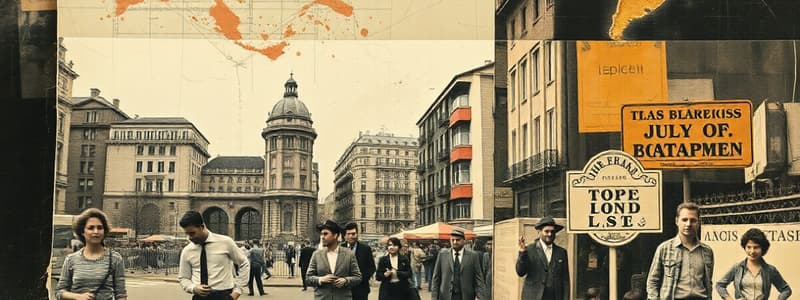Podcast
Questions and Answers
How do social groups maintain spatial distance according to urban social landscape theories?
How do social groups maintain spatial distance according to urban social landscape theories?
Social groups maintain spatial distance through segregation into distinct neighborhoods.
What are the three primary forces that social area analysis identifies as shaping urban areas?
What are the three primary forces that social area analysis identifies as shaping urban areas?
The three primary forces are advanced job skills, changing family structures, and increased residential mobility.
In what way has the Chicago or ecological school been criticized regarding human behavior?
In what way has the Chicago or ecological school been criticized regarding human behavior?
It has been criticized for reinforcing racism and segregation by using biological sciences to explain complex human behavior.
According to Murdies (1969), what three forces help identify social areas in cities?
According to Murdies (1969), what three forces help identify social areas in cities?
What complexities of social identity are often overlooked in metropolitan areas?
What complexities of social identity are often overlooked in metropolitan areas?
What was the primary focus of urban scholars in the late 19th and early 20th century regarding urbanization?
What was the primary focus of urban scholars in the late 19th and early 20th century regarding urbanization?
How did Simmel describe the influence of urban environments on social behavior?
How did Simmel describe the influence of urban environments on social behavior?
What does the phrase 'community lost' imply in the context of early urban studies?
What does the phrase 'community lost' imply in the context of early urban studies?
Describe the approach taken by the Chicago School of Urban Sociology towards understanding urban society.
Describe the approach taken by the Chicago School of Urban Sociology towards understanding urban society.
In what way did early scholars differentiate the urban community from traditional communities?
In what way did early scholars differentiate the urban community from traditional communities?
Flashcards are hidden until you start studying
Study Notes
Urban Social Landscapes
- Urban geographers study the spatial organization of urban society.
- Early 20th-century scholars argued that urbanization led to the death of community.
- Traditional communities were based on close relationships, familial ties, and shared beliefs and rituals.
- These early scholars argued that urban societies focused on economic organization, leading to short-lived and superficial social interactions.
- Social order in cities was based on differences and the division of labor.
Simmel’s Theory of Urban Life
- Simmel argued that cities have an adverse influence on society.
- Dynamic density: Larger populations lead to weaker social controls and behavior.
- Rationality/impersonality: Economic relationships dominate social interactions.
- Overstimulation: The constant “press” of people causes some to withdraw for privacy.
- Anomie: Increased social isolation.
- Deviant behavior: These factors can contribute to deviant behavior.
The Chicago School of Urban Sociology
- Burgess and Park observed social groups in specific urban contexts and how urban society is organized spatially.
- Cities were viewed as “natural” or “ecological” communities.
- This perspective used a scientific approach to explain social patterns based on competition for resources.
- Concepts like social distance emphasized that different social groups sought to minimize contact, often achieved through spatial distance.
- Neighborhoods: Distinct, sometimes segregated neighborhoods emerged due to these dynamics.
- Invasion and succession: Neighborhoods experienced change over time through these processes.
- Social Area Analysis: Three primary forces shape urban areas:
- Advanced job skills: Increasing importance of specialized skills.
- Family structures: Evolution of family structures.
- Residential mobility: Increased movement of people between places.
Murdie’s Urban Mosaic
- Three forces create social areas in cities:
- Socio-economic status: Economic standing and resources.
- Family status: Family formation and composition.
- Ethnic status: Cultural and ethnic backgrounds.
Criticisms of the Chicago School
- Concerns about reinforcing racism and segregation.
- Using biological sciences to explain complex human behavior is problematic and can be seen as social Darwinism.
- Ignores complex social, economic, and political forces influencing human behavior.
- Social identity in cities is more complex, incorporating factors like race, gender, sexuality, age, and lifestyle.
Studying That Suits You
Use AI to generate personalized quizzes and flashcards to suit your learning preferences.




